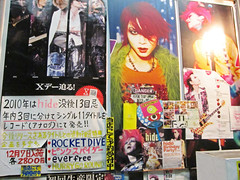TOKYO – Born Hideto Matsumoto, the man who would be known solely by his nickname, “Hide,” was one of the greatest entertainment figures whom most Americans have never heard of. Much of that has to do with his being Japanese and based out of Japan, but more has to do with his tragic death right before making his international debut. This man set off the chain of events that led me to travel to Japan.
 Hide began his Japan-conquering music career in Yokosuka, home to one of the largest United States military bases in Japan. Hide exuded Western influence – citing KISS as one of his early influences – which led him to start one of the first Japanese glam/heavy metal bands, Yokosuka Saver Tiger, between 1981 and 1987.
Hide began his Japan-conquering music career in Yokosuka, home to one of the largest United States military bases in Japan. Hide exuded Western influence – citing KISS as one of his early influences – which led him to start one of the first Japanese glam/heavy metal bands, Yokosuka Saver Tiger, between 1981 and 1987.
While this band produced two other successful musicians that continue to make their mark on Japanese music, Yokosuka Saver Tiger was troubled by frequent member turnover to the point that Hide gave up music to go to beauty school.
However, Hide got another chance at rock stardom when he was recruited into a band called X, which also had problems keeping a steady lineup. After Hide’s addition, the band took over the Japanese rock market and then stormed the popular conscious, winning over young girls and becoming the first Japanese rock band to sell out the Tokyo Dome, which has 50,000 seats.
After the band signed a U.S.-based record contract with Atlantic Records, worldwide success seemed to be the next step (they renamed themselves X Japan as so not be confused with the American band X). The band sought a more contemporary sound, but after 1993’s “Art of Life,” the band spurted out, rarely touring and releasing only one more album before breaking up in 1997.

In the meantime, Hide vigorously pursued a solo career that blew off genre conventions. Bouncing among rock, industrial and things lacking good definitions, he became widely successful with a self-named project.
He prepared his own entry into the global market with an industrial band named Zilch, consisting of himself singing in English with Western band members, such as Joey Castillo from Queens of the Stone Age. He was about to take on the world with Zilch, rumored to be touring with Marilyn Manson at the height of his popularity, when, on May 2, 1998, Hide was found dead at 33, hanging from a doorknob by a towel.
His friends insisted it was an accident (and still do), while the police officially determined it was a suicide. Three fans are known to have killed themselves after hearing the news, and tens of thousands turned out to his funeral.
Months later, Zilch’s album “3.2.1” and Hide’s third solo album, “Ja, Zoo” came out. Hide’s solo album attacked the charts and spawned several No. 1 singles, while Zilch continued on for a few more years with a different sound. In 2007, X Japan reunited and brought Hide back to the stage in 2008 with a holograph machine.
The band finally toured America in 2010, featuring Hide’s guitar work as a backtrack. Reaction to this tribute was mixed, but the band’s American debut was well-received.
Through both X Japan and his solo project, Hide left a huge influence on Japanese rock. To this day, many Japanese guitarists from a wide range of bands play his brand of guitar and cite him as inspiration for taking up the six-string.
Bands continue to try to capture his bright quirky dress style and his spirit, with mixed results. The gap between the mainstream Japanese rock and visual rock scenes continues to grow (visual rock continues to get more elaborately costumed but less often musically interesting) – probably something Hide wouldn’t have liked.
As for me, I didn’t have any passion for music or fashion before I discovered his work. It wasn’t long before I was dying my hair and playing the air guitar to almost exclusively Japanese music. More than that was his influence that gave me the confidence to express myself.
While I no longer listen to his bands on a near-daily basis, I am still extremely passionate about Japanese bands. That love of music is really what keyed off my initial interest in Japan. Taking the two-hour trip from Tokyo to his grave in the city of Miura was something I’d always felt I needed to do.
As I left him an offering, it was as though things came full circle. As I talk to musicians and write material for my first band stateside, his influence continues to live on.
Lee Miller can be reached at lee.miller0001@temple.edu.



Be the first to comment